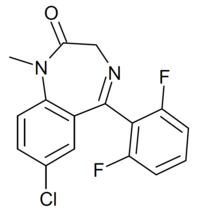Difludiazepam
Difludiazepam[1] (Ro07-4065) is a benzodiazepine derivative which is the 2',6'-difluoro derivative of fludiazepam. It was invented in the 1970s but was never marketed, and has been used as a research tool to help determine the shape and function of the GABAA receptors, at which it has an IC50 of 4.1nM.[2][3][4] Difludiazepam has subsequently been sold as a designer drug, and was first notified to the EMCDDA by Swedish authorities in 2017.[5]
 | |
| Legal status | |
|---|---|
| Legal status |
|
| Identifiers | |
| |
| CAS Number | |
| PubChem CID | |
| ChemSpider | |
| ChEMBL | |
| Chemical and physical data | |
| Formula | C16H11ClF2N2O |
| Molar mass | 320.72 g·mol−1 |
| 3D model (JSmol) | |
| |
| |
See also
References
- Maskell PD, Wilson NE. Designer Benzodiazepines: New Challenges and Treatment Options, in Corazza O, Roman-Urrestarazu. Handbook of Novel Psychoactive Substances: What Clinicians Should Know about NPS. Taylor & Francis, 2019. ISBN 978-1-138-06830-8
- Winkler DA, Burden FR, Watkins AJ (January 1998). "Atomistic Topological Indices Applied to Benzodiazepines using Various Regression Methods". Quantitative Structure-Activity Relationships. 17 (1): 14–19. doi:10.1002/(SICI)1521-3838(199801)17:01<14::AID-QSAR14>3.0.CO;2-U.
- So SS, Karplus M (December 1996). "Genetic neural networks for quantitative structure-activity relationships: improvements and application of benzodiazepine affinity for benzodiazepine/GABAA receptors". Journal of Medicinal Chemistry. 39 (26): 5246–56. doi:10.1021/jm960536o. PMID 8978853.
- Maddalena DJ, Johnston GA (February 1995). "Prediction of receptor properties and binding affinity of ligands to benzodiazepine/GABAA receptors using artificial neural networks". Journal of Medicinal Chemistry. 38 (4): 715–24. doi:10.1021/jm00004a017. PMID 7861419.
- "Europol 2017 Annual Report on the implementation of Council Decision 2005/387/JHA. EMCDDA" (PDF). 2018.
This article is issued from Wikipedia. The text is licensed under Creative Commons - Attribution - Sharealike. Additional terms may apply for the media files.